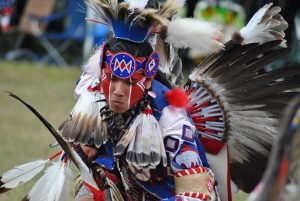The Importance of the Sacred, Secular and Spiritual
The Importance of the Sacred, Secular and Spiritual
Topic 6 – The Importance of the Sacred, Secular and Spiritual
Sacred, secular and spiritual connectedness is at the root of Indigenous worldviews, events, and teachings. According to Hoffman,
“Aboriginal ontologies and epistemologies are rooted in worldviews that are inclusive of both the sacred and the secular. [In Indigenous ontologies] the world exists in one reality composed of an inseparable weave of secular and sacred dimensions” (2013, p. 190).
Indigenous teachings and activities integrate deeper meaning beyond the obvious and connect to ancestors and the surrounding living world.

Pow Wows are examples of events with deep interconnectedness involving ceremony, regalia, drums, music, food, dance, and celebration. They are intergenerational, practice spiritual healing and have etiquette and protocols to observe such as abstinence from drugs and alcohol at a Pow Wow. They are hosted all across Turtle Island (the land we now call North America).
There are many traditions depending on the nations featured (there are over 600 nations in the land we now call Canada). Some Pow Wows are competitions and others are ceremonies. Some elements are considered sacred such as the Grand Entry, the Opening Prayer and lighting of the Sacred Fire. Remember to ask when it is ok to take pictures and have tobacco on hand to honour and show respect when asking questions of Elders.
Smudging is another practice that involves burning one or more of the sacred four medicines (sage, cedar, tobacco and sweetgrass) while reflecting and engaging in reflective cleansing. Begin with the cleansing of the air, then the mind, eyes, ears and mouth to see, hear, and speak well of others. It also involves letting go of the negatives and is part of living a good life and welcomes cleansing of the spirit and emotions (Ontario Federation of Labour, 2019).
The Importance of Smudging
Jaimie discusses what smudging is and what it means to her (5:02).
The Learning Spirit
In the Aboriginal Learning: A Review of Current Metrics of Success Tunison (2007) explores the academic success gap in Aboriginal learning by identifying a crucial element to Aboriginal student learning successes and defines that element as the “Learning Spirit”. By redefining what success looks like and feels like from the Aboriginal learner perspective, educators will be knowledgeable in how to support the learning spirit that is within students.
Explore a story in the video (6:12) about the impact of the damage that can be done to one’s Learning Spirit, in addition to a visit to the Mount Elgin – Indian Residential School Monument, which was erected in 2012. There are seven stone pillars with each pillar containing names of children who attended Mt. Elgin Industrial Institute. Children attended from all over Ontario and Michigan. Each of the seven pillars correspond to one of the Anishinaabe Seven Grandfather Teachings. Read more about the memorial and its story in an article from November 4, 2021, for the Anishinabek News.
Reference:
Hoffman, R. (2013). Respecting Aboriginal knowledge in the academy. Alternative: An International Journal of Indigenous Peoples, 9(3), 189-203.
Ontario Federation of Labour. (June, 2019). Guidelines for Indigenous Smudge Ceremony. Retrieved Dec 18, 2021 from https://ofl.ca/wp-content/uploads/2019.06.21-OFL-FNMI-Guidelines-for-Indigenous-Smudge-Ceremony.pdf
Tunison, S. 2007. Aboriginal Learning: A Review of Current Metrics of Success. University of Saskatchewan, Aboriginal Education Research Centre, Saskatoon, Saskatchewan and First Nations and Adult Higher Education Consortium, Calgary, Alberta. Retrieved from: http://en.copian.ca/library/research/ccl/aboriginal_learning_review/aboriginal_learning_review.pdf

